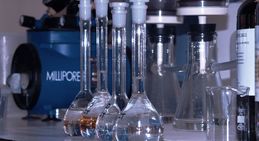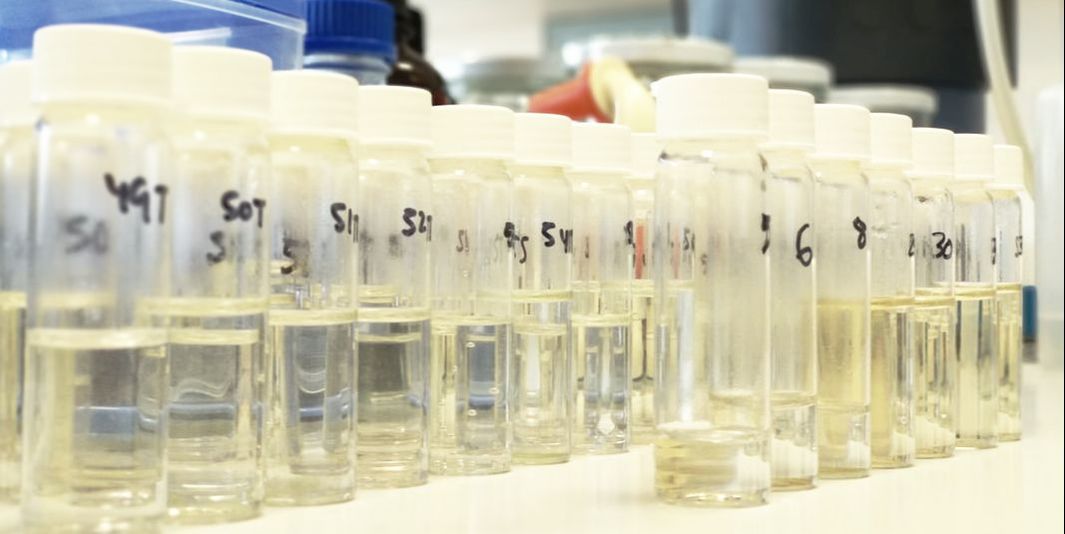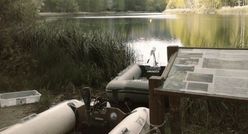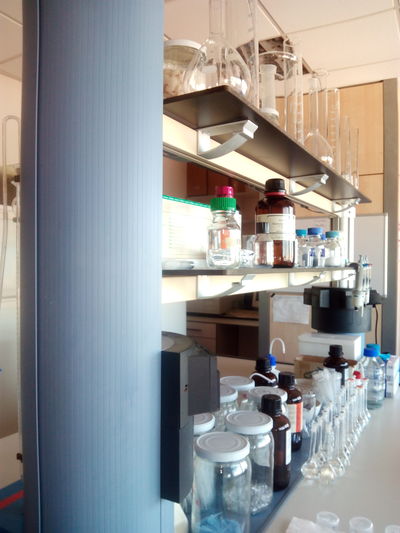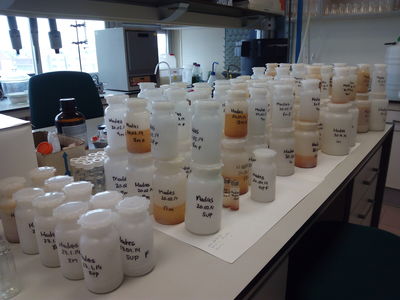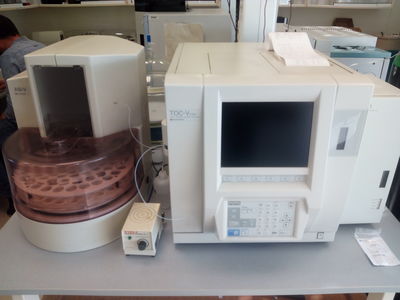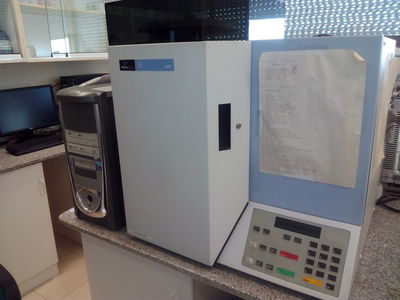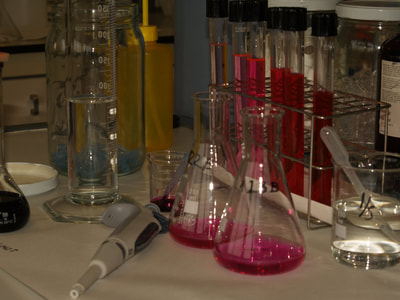Facilities and analyses
|
Our laboratory is located in the ICA building (5th floor) and supports several chemical and physical analyses for research on biogeochemistry, mainly focused on aquatic freshwater ecosystems (wetlands, lakes and rivers) but equipped to study also terrestrial and marine ecosystems. The laboratory has the potential to perform a wide range of soil/sediment, plant/vegetation and water chemistry analyses commonly associated with elemental cycling research (C, N and P). Equipment includes chemical instrumentation for quantifying soluble and particulate substance concentrations, drying ovens, incubators, balances, a muffle furnace, filtering apparatus, vacuum hoods, sampling devices, PC's and printers. |
For any question related with the laboratory, including support, equipment, samples or analysis request, please contact to José Luis Ayala
Available instrumental in the laboratory:
|
1) Perkin Elmer 2400 Serie II for elemental analysis (CHNO)
2) Perkin Elmer Lambda 35 spectrophotometer 3) Shimadzu TOC-V CSH coupled with a TNM-1 for dissolved carbon and nitrogen analyses 4) SEAL Analytical AutoAnalyzer 3 5) Agilent Technologies 6890N gas chromatograph for CO2 and CH4 analysis 6) Multi-gas analyzer GASERA ONE pulse, based on cantilever enhanced photoacustic spectrometry for CO2, CH4, N2O and NH3 measurement. |
For field campaings the following equipment is also available:
|
1) Niskin bottles
2) Crison MM40 pH and conducitivimeter 3) CTD SEABRIR SBE 19Plus 4) YSI oxymeter ProODO 5) YSI 6920 V2 multi-parameter sonde 6) Hach HQ40d multi-parameter sonde (oxygen and ORP) 7) FP101 Flowprobe Global Water sonde for water flow measurements 8) Furuno FE-450 Echosound 9) Portable infrared gas analyzer (IRGA) model 225 MK3 (ADC BioScientific) for leaf-level photosynthesis, transpiration, and stomatal conductance 10) AccuPAR LP-80 Ceptometer (Decagon Devices Inc.) for LAI measurements 11) Closed soil respiration chamber SRC-1 connected to an EGM-4 CO2 gas analyzer (PP-systems) 12) Multi-gas analyzer GASERA ONE pulse, based on cantilever enhanced photoacustic spectrometry for CO2, CH4, N2O and NH3 13) Soil moisture and temperature EC-10 and EC-T ECH2O probes (Decagon Devices Inc.) 14) Zodiac inflatable and portable boats |
Available analyses in the laboratory:
1) In water samples:
- Total organic carbon (TOC) in water samples, including particulate organic carbon (POC), dissolved organic carbon (DOC) and total nitrogen (TN)
- Ammonium, nitrite, nitrate, orthophosphate and total phosphorus (TP), following APHA (2005)
- Total solids (110 ºC), total mineral and organic matter (loss of ignition 550 ºC), suspended solids, carbonates-bicarbonates, clorides, sulfates, calcium, magnesium, sodium, potasium, silica, total, temporary and permanent hardness, following APHA (2005)
- Water colour (ʎ = 440 nm, in mg Pt/l)
- Chlorophyll-a (after methanol extraction, following Maker et al. (1980)
- Dissolved oxygen by the Winkler (tritation) method, following APHA (2005)
- Dissolved gas analyses of CO2, CH4 and N2O by photoacustic spectrometry
- Soil water content (gravimetric method)
- Elemental analysis of C, N and P (after acid digestion using ammonium persulfate/sulfuric acid)
- Nutrient extraction (nitrogen with CaCl2 and assimilable phosphorus with the Olsen method) for further analysis following previous description (see 3)
- Carbonates using the Bernard calcimeter
- Microbial biomass C, N and P by chloroform fumigation-incubation method (Brookes et al. 1985, Inubushi et al. 1991, Ivanoff et al. 1998, Witt et al. 2000, Truu et al. 2009, Sánchez-Carrillo et al. 2014) and then measured by the Shimadzu TOC-V analyzer (C and N) and by the SEAL autoanalyzer (P, after acid digestion; see above)
- Chlorophyll-(a+b) after methanol extraction and following Porra, Thompson and Kriedemann (1989)
- Elemental analysis of C, N and P (after acid digestion using ammonium persulfate/sulfuric acid)
- CO2 and CH4 by gas chromatography
- CO2, CH4, N2O and NH3 by photoacustic spectrometry
References
APHA (2005) Standard Methods for the Examination of Water and Wastewater. American Public Health Association, Washington DC.
Marker AFH, Nusch EA, Rai H, Rieman B (1980) The measurement of photosynthetic pigments in freshwater and standardisation of methods: conclusions and recommendations. Archiv für Hydrobiologie 14: 91-106.
Brookes PC, Landman A, Pruden G, Jenkinson DS (1985) Chloroform fumigation and the release of soil nitrogen: a rapid direct extraction method to measure MBNitrogen in soil. Soil Biology and Biochemistry 17: 837-842.
Inubushi K, Brookes PC, Jenkinson DS (1991) Soil MBC, N and ninhydrin-N in aerobic and anaerobic soils measured by the fumigation-extraction method. Soil Biology and Biochemistry 23:737–741
Ivanoff DB, Reddy KR, Robinson S (1998) Chemical fractionation of organic P in histosols. Soil Science 163:36-45
Witt C, Gaunt JL, Galicia CC, Ottow JCG, Neue H-U (2000) A rapid chloroform-fumigation ex-traction method for measuring soil MBCarbon and nitrogen in flooded rice soils. Biology and Fertility of Soils 30:510–519
Truu M, Juhanson J, Truu J (2009) Microbial biomass, activity and community composition in constructed wetlands. Science of Total Environment 407: 3958-3971
Sánchez-Carrillo S, Reddy KR, Inglett KS, Álvarez-Cobelas M, Sánchez-Andrés R (2014) Biogeochemical indicators of nutrient enrichment in wetlands: microbial response as a sensitive indicator of wetland eutrophication. En: AA Ansari, SS Gill (eds), Eutrophication: Causes, Consequences and Control Vol 2. Springer, Berlin. pp. 203-222.
Porra RJ, Thompson WA, Kriedemann PE (1989) Biochimica et Biophysica Acta 975: 384-394.
Marker AFH, Nusch EA, Rai H, Rieman B (1980) The measurement of photosynthetic pigments in freshwater and standardisation of methods: conclusions and recommendations. Archiv für Hydrobiologie 14: 91-106.
Brookes PC, Landman A, Pruden G, Jenkinson DS (1985) Chloroform fumigation and the release of soil nitrogen: a rapid direct extraction method to measure MBNitrogen in soil. Soil Biology and Biochemistry 17: 837-842.
Inubushi K, Brookes PC, Jenkinson DS (1991) Soil MBC, N and ninhydrin-N in aerobic and anaerobic soils measured by the fumigation-extraction method. Soil Biology and Biochemistry 23:737–741
Ivanoff DB, Reddy KR, Robinson S (1998) Chemical fractionation of organic P in histosols. Soil Science 163:36-45
Witt C, Gaunt JL, Galicia CC, Ottow JCG, Neue H-U (2000) A rapid chloroform-fumigation ex-traction method for measuring soil MBCarbon and nitrogen in flooded rice soils. Biology and Fertility of Soils 30:510–519
Truu M, Juhanson J, Truu J (2009) Microbial biomass, activity and community composition in constructed wetlands. Science of Total Environment 407: 3958-3971
Sánchez-Carrillo S, Reddy KR, Inglett KS, Álvarez-Cobelas M, Sánchez-Andrés R (2014) Biogeochemical indicators of nutrient enrichment in wetlands: microbial response as a sensitive indicator of wetland eutrophication. En: AA Ansari, SS Gill (eds), Eutrophication: Causes, Consequences and Control Vol 2. Springer, Berlin. pp. 203-222.
Porra RJ, Thompson WA, Kriedemann PE (1989) Biochimica et Biophysica Acta 975: 384-394.
